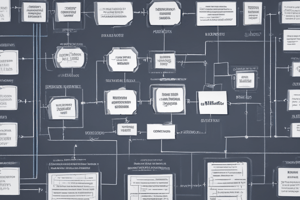Podcast
Questions and Answers
What is true about the interaction in use case descriptions?
What is true about the interaction in use case descriptions?
- It is among products
- It is among products and actors (correct)
- It is between actors
- It is among actors and use cases
What are the essential components of use case descriptions?
What are the essential components of use case descriptions?
- Use case name and number
- Use case name, number, actors, and stakeholder needs (correct)
- Actors and stakeholders
- Stakeholder needs and preconditions
What is true about the trigger in a use case?
What is true about the trigger in a use case?
- It is a postcondition guaranteed to be true
- It is a precondition that must be true
- It is an event that causes the use case to begin (correct)
- It is an event that occurs during the activity
What is the purpose of indentation in the use case description format?
What is the purpose of indentation in the use case description format?
What is true about writing use case descriptions?
What is true about writing use case descriptions?
What is the correct order to fill in the use case template?
What is the correct order to fill in the use case template?
What type of sentences should be written in a use case?
What type of sentences should be written in a use case?
What should be avoided in a use case?
What should be avoided in a use case?
What is a characteristic of a different alternative in a use case?
What is a characteristic of a different alternative in a use case?
What is true about interactions in a use case?
What is true about interactions in a use case?
Flashcards are hidden until you start studying
Study Notes
Use Case Descriptions
- Use case descriptions consist of interactions among a product and an actor.
- A use case description includes the use case name and number, actors, and stakeholders and needs.
Preconditions and Postconditions
- A precondition is an assertion guaranteed to be true before the activity or operation begins.
- A postcondition is an assertion guaranteed to be true when the activity or operation finishes.
Triggers
- A trigger is an event that causes a use case to begin.
Use Case Description Format
- Underline text refers to another use case.
- Extensions section uses complicated numbering scheme.
- Indentation is used to make extensions easier to read.
Methods of Writing Use Case Descriptions
- Actors in a use case are almost always stakeholders.
- Preconditions must be true before the statement begins.
- Need list should be reviewed when writing each use case.
Extensions
- Once the basic flow is defined, the extensions can be specified.
- The alternatives are called extensions as they extend the activity flow in a different direction from a branch point.
Use Case Description Heuristics
- Fill in the use case template from top to bottom.
- Write simple declarative sentences in active voice.
- Avoid sequence of steps by the actors and product.
Alternative Use Cases
- A different alternative must consist of different overall product functionality.
Use Case Diagrams
- Interactions supported by a product are cataloged in a use case description.
- Interactions are refined in a use case diagram.
Use Case Driven Iterative Development
- At each iteration, one or more use cases are selected for implementation.
- Iteration should be followed until the system is complete.
- Iterative development builds system functionality gradually through analysis, design, coding, testing, and evaluation.
Studying That Suits You
Use AI to generate personalized quizzes and flashcards to suit your learning preferences.



